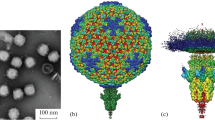Summary
Mouse adenovirus, strain FL (MAV), is best propagated in primary rather than secondary cultures of mouse kidney cells. Virus release from the cells into the medium is fairly efficient; the average yield per cell is about 1000 TCID50. Morphological and other biophysical characteristics are those of a typical adenovirus: the icosahedral shell with a diameter of 74 nm, fiber projections of 29 nm length, its localization inside the infected kidney cells, a buoyant density in CsCl of 1.34 g/ml, inhibition of multiplication by inhibitors of DNA synthesis. The thermostability is higher than that of human adenoviruses, whereas, in contrast to these, MAV is inactivated to a great extent by trypsin. Complete or incomplete hemagglutinin or toxin-like activity were not detected.
The virus shows no cross-neutralization with human adenoviruses and a one-sided cross-reaction with another murine adenovirus strain K87. Soluble complement-fixing antigen of MAV exhibits a sedimentation rate of 12S identical to the hexon component of human adenoviruses; both antigens show a partial antigenic relationship in tests with appropriate antisera.
Similar content being viewed by others
References
Bartha, A.: Proposal for subgrouping of bovine adenoviruses. Acta Vet. Acad. Sci. Hung.19, 319–321 (1969).
Blailock, Z. R., Rabin, E. R., Melnick, J. L.: Adenovirus endocarditis in mice. Science157, 69–70 (1967).
Blailock, Z. R., Rabin, E. R., Melnick, J. L.: Adenovirus myocarditis in mice—an electron microscopic study. Exp. mol. Pathol.9, 84–96 (1968).
Gelderblom, H., Bauer, H., Frank, H., Wigand, R.: The structure of group II adenoviruses. J. gen. Virol.1, 553–560 (1967).
Gelderblom, H., Ogura, H., Bauer, H.: On the occurrence of oncornavirus-like particles in HeLa cells. Cytobiologie8, 339–344 (1974).
Ginsberg, H. S.: Characteristics of the new respiratory viruses (adenoviruses). II. Stability to temperature and pH alterations. Proc. Soc. exp. Biol.93, 48–52 (1956).
Hartley, J. W., Rowe, W. P.: A new mouse virus apparently related to the adenovirus group. Virology11, 645–647 (1960).
Hashimoto, K., Sugiyama, T., Sasaki, S.: An adenovirus isolated from feces of mice. I. Isolation and identification. Japan. J. Microbiol.10, 115–125 (1966).
Hashimoto, K., Sugiyama, T., Yoshikawa, M., Sasaki, S.: Intestinal resistance in the experimental enteric infection of mice with a mouse adenovirus. I. Growth of the virus and appearance of a neutralizing substance in the intestinal tract. Japan. J. Microbiol.14, 381–395 (1970).
Missal, O.: Isolierung von Adenovirus aus einer Mäusekolonie und dessen Charakterisierung. 2. Mitteilung. Arch. exp. Vet. Med. (Leipzig)23, 783–791 (1969).
Norrby, E.: The structural and functional diversity of adenovirus capsid components. J. gen. Virol.5, 221–236 (1969).
Norrby, E., Bartha, A., Boulanger, P., Dreizin, R. S., Ginsberg, H. S., Kalter, S. S., Kawamura, H., Rowe, W. P., Russell, W. C., Schlesinger, R. W., Wigand, R.: Adenoviridae. Intervirology7, 117–125 (1976).
Pettersson, U., Philipson, L., Höglund, S.: Structural proteins of adenoviruses. I. Purification and characterization of the adenovirus type 2 hexon antigen. Virology33, 575–590 (1967).
Rowe, W. P., Hartley, J. W., Huebner, R. J.: Serotype composition of the adenovirus group. Proc. Soc. exp. Biol.97, 465–470 (1958).
Takeuchi, A., Hashimoto, K.: Electron microscope study of experimental enteric adenovirus infection in mice. Infect. Immun.13, 569–580 (1976).
van der Veen, J., Mes, A.: Experimental infection with mouse adenovirus in adult mice. Arch. ges. Virusforsch.42, 235–241 (1973).
van der Veen, J., Mes, A.: Serological classification of two mouse adenoviruses. Arch. ges. Virusforsch.45, 386–387 (1974).
Wallis, C., Yang, C.-S., Melnick, J. L.: Effect of cations on thermal inactivation of vaccinia, herpes simplex, and adenoviruses. J. Immunol.89, 41–46 (1962).
Wigand, R., Gelderblom, H., Kron, I., Liem, I. T. F.: Structure, hemagglutinins, and subgroup position of adenovirus 20, 25, and 28. Arch. ges. Virusforsch.38, 167–176 (1972).
Wigand, R., Klein, W.: Properties of adenovirus substituted with iododeoxyuridine. Arch. ges. Virusforsch.45, 298–300 (1974).
Wigand, R., Schmieder, J.: Inhibition of adenovirus multiplication by metabolic inhibitors. Arch. ges. Virusforsch.42, 324–338 (1973).
Wrigley, N. G.: The lattice spacing of crystalline catalase as an internal standard of length in electron microscopy. J. ultrastruct. Res.24, 454–464 (1968).
Author information
Authors and Affiliations
Additional information
With 9 Figures
Aided by a grant from the Bundesministerium für Jugend, Familie und Gesundheit, Federal Republic of Germany.
Rights and permissions
About this article
Cite this article
Wigand, R., Gelderblom, H. & Özel, M. Biological and biophysical characteristics of mouse adenovirus, strain FL. Archives of Virology 54, 131–142 (1977). https://doi.org/10.1007/BF01314385
Received:
Accepted:
Issue Date:
DOI: https://doi.org/10.1007/BF01314385




